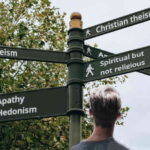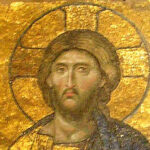For those of us who are reconstructing our Christian faith, Christmas is a special problem.
Celebrating Christmas is a tradition, something most of us have known since were were small children. The Christmas story sits alongside nativity displays, Christmas carols and Santas in our shopping malls ever since Halloween, presents and a tree, Christmas lights, and all the rest.
But is the story of Jesus’ birth in a stable because there was no room in the inn a sweet but fanciful story just like Santa delivering toys all over the world?
What can we honestly believe and celebrate?
What do historians say?
When expert historians examine the life of Jesus as recorded in the four gospels, the stories they question most are those of his birth. (Christian scholar Craig Keener didn’t even discuss Jesus’ birth in his monumental The Historical Jesus of the Gospels.)
So how critical should we be when looking at these familiar stories? How much is true and how much is uncertain or unlikely? Where they differ, should we trust Matthew or Luke?
Some relatively recent analysis gives us extra confidence in Luke’s version of events.
Critical assessment of the stories
Of the four gospels, only Matthew and Luke relate the events of Jesus birth, and there are many variations between them. One important criterion of assessing the historicity of ancient accounts is whether there is independent corroboration of the events. We don’t have any independent historical evidence for the events of Jesus’ birth outside Matthew and Luke. So where they agree, we can have more confidence, but where they relate different aspects, we have to decide on the evidence of one account only.
What they agree on
Matthew and Luke agree that:
- Jesus was a real person who was born in Bethlehem sometime around the year we now call 1 CE (give or take half a decade).
- Mary was his mother and Joseph was his apparent father. However Mary was a virgin, and the baby was conceived miraculously while they were still betrothed.
- Joseph, Mary & Jesus went to live in Nazareth.
- Several times God announced and explained what was going on via angels.
Things in Matthew but not in Luke
- The Magi came from the east after seeing a sign in the stars, visited Herod and then Bethlehem to find the child Jesus and Mary.
- Herod gave orders to kill all boys in and near Bethlehem under the age of 2.
- Mary, Joseph and Jesus escaped to Egypt until Herod died (which happened in about 4 BCE, historians believe).
- On return from Egypt, they bypassed Bethlehem and settled in Nazareth.
Things in Luke but not in Matthew
- Joseph and Mary travelled from Nazareth to Bethlehem just before Jesus was born, to take part in a census carried out by governor Quirinius .
- There was limited accommodation, so the newborn Jesus was placed in a manger.
- Shepherds received a message from angels and went to Bethlehem to see the baby.
- Joeseph and Mary took Jesus to the temple in Jerusalem for purification and other rites
Are the two accounts compatible and reliable?
Historians generally doubt the accuracy of those things only mentioned by one or other of the gospel writers, and at most accept only those matters where both agree.
On the surface, the two accounts are feasible and can be fitted together. We just have to suppose that Matthew omits Luke’s information about the census, the travel from Nazareth and the limited accommodation, while there is a long gap in Luke’s story when the family travelled to Egypt. But on a closer look, there are some difficulties.
Herod died in 4 BCE, so if Matthew’s story that Herod was alive at the time of Jesus’ birth is correct (and Luke 1:5 agrees with Matthew here), Jesus was born about 5 BCE. But historians don’t believe Quirinius was governor of Syria until 6 CE, and it was then, it is thought, that the first census was held in Palestine.
There are explanations explaining these anomalies and based on some evidence, but there remains considerable doubt. Perhaps the most reasonable possibility is that Quirinius held a position of power (though not the actual governor) around 6 BCE and conducted a census then.
There is also no other historical record of Herod killing children in Bethlehem, although it may be argued that if Bethlehem was only a small village, only a small number of children might have been killed, and this may have attracted little attention in later accounts. Certainly Herod is known to have been ruthless enough for this.
The genealogies of Jesus given by Matthew and Luke disagree significantly, but since they seem to be more stylised or symbolic than historical (e.g. Matthew divides his genealogy into three groups of 14 names), I don’t think this is significant.
Overall, scholars have tended to accept Matthew’s date, and been somewhat doubtful of most of the other details of both accounts, including Jesus being born in Bethlehem. The virgin birth is generally treated as something beyond historical analysis.
Apparently ancient biographers often began their stories in a fanciful way, to express something about their subject. Some historians think this may have happened here, to emphasise their belief that Jesus was the Messiah from the tribe of David, born in Bethlehem as predicted by the prophet Micah (5:2).
I tend to trust Luke’s reliability, and am more circumpect about Matthew, who seems more prone to include accounts that may be theologically meaningful but not historically accurate.
And there is information that makes Luke’s account very believable.
Four insights from the text of Luke
In 2010, Stephen Carlson’s paper The Accommodations of Joseph and Mary in Bethlehem: Κατάλυμα in Luke 2.7 was published by Cambridge University Press. It is fascinating reading and makes four basic points.
1. Joseph’s family likely lived in Bethlehem
Luke says that there was a census and “everyone went to their own town to register” (2:3). Although Luke also mentions that Bethlehem was Joseph’s ancestral home because he came from the line of David (2:4), there is no record of Roman censuses requiring people to go to their ancestral home (the concept may not have meant much elsewhere). But Carlson says that “Roman censuses registered people by their residence and by where they own their fields”, which seems quite practical, as it would have allowed a correct evaluation of assets, income and ability to pay.
So it seems most likely that Joseph’s family, and Joseph himself, owned property in Bethlehem. If there wasn’t a large Roman census at that time, there may have been some other government or business requirement that Luke hasn’t described accurately.
2. There was no inn
The Greek word Κατάλυμα that was once translated as inn, is better translated as simply “a place to stay”. The NIV calls it “guest room”, which is closer to the right idea.
Since Joseph apparently had family in Bethlehem, hospitality and honour would not have allowed the couple to stay anywhere except in the home of family.
3. Ancient Jewish betrothal practices
Carlson says: “According to Jewish practices in antiquity, marriages were initiated by a betrothal and finalized by a ‘home-taking’ in which the bride is taken to her husband’s house. Both events were celebrated by a public feast, the former at the bride’s house and the latter at the groom’s house.”
It therefore seems likely that the census (or whatever it was) and the betrothal/marriage took place around the same time, and Joseph and Mary were betrothed in Nazareth and married soon after their arrival in Bethlehem. Only then would they have began to live together.
4. There was no stable
Houses at that time had few rooms, and extra rooms (attached, or on a second storey) were often added as required. So when children were married they often lived for a time in a small marital chamber in the groom’s family home. But this small room was designed for newly married couples without children, and wouldn’t have been large enough for the relatives and midwives who would have assisted with the birth, and so Mary had to deliver her child in another room.
Many houses of that time had a large room on two levels. The family (parents and children) would all sleep in the upper level while animals might be in the lower level – in winter this might be the best way to keep both stock and family warm. There would have been feeding troughs (“mangers”) between the two levels.
So rather than there being no room at the inn, it seems likely there was insufficient room in the marital chamber.
And so perhaps the story went like this ….
It was arranged that Joseph and Mary get married. Whether Joseph was living in Bethlehem at the time, or in Nazareth, we don’t know, nor do we know how the families knew each other. Even though Mary was now pregnant, Joseph would have surprised everyone by continuing with the betrothal.
To formalise the betrothal, Joseph attended ceremonies in Nazareth, Mary’s home town, then took her on the long journey to his home town of Bethlehem. There they were married, with much feasting, and then moved into a small room attached to Joseph’s family home.
But the room was small, so when labour began, Mary moved into the main room and, assisted by family and midwives, gave birth to Jesus. The baby was laid in a manger because there wasn’t a lot of spare room.
The couple stayed in Bethlehem for at least 40 days, the set time for purification after birth, perhaps in nearby Jerusalem. Some time later they moved back to Galilee, where Joseph worked as a builder or carpenter.
The story comes alive
Carlson’s reconstruction makes sense in the context of first century Judaism, and makes the story come alive to me.
I don’t understand why Joseph moved from Bethlehem to Nazareth, whether this was before the betrothal or after the wedding, but the rest of the story is easily pictured and understood.
So, are the stories of Jesus’ birth historically true?
I don’t think this is as important a question as some christians do. But I think the evidence points to a true story with some symbolic elements. So with my new understanding of Luke’s story, I’m inclined to accept Luke’s account as trustworthy. Perhaps Luke’s census story is mistaken, but perhaps there was indeed an earlier census.
It is Matthew’s account that leaves me in most doubt. The Magi, Herod’s killing of children and the family’s flight to Egypt all seem inherently less likely, even though possible.
I’ll continue to trust Luke and remain noncommital about Matthew.
The important thing, which both accounts agree on, is that Jesus was a real person born to Mary in about 3-7 BCE, that his followers believed him to be the Messiah and they expressed this belief through the stories (whether historical or not) that were told about his birth.
We can believe that much with complete integrity, and sit loosely on the rest.
So have a happy Christmas remembering the baby born in the main room of Joseph’s family house, and who was destined to “shine on those living in darkness and in the shadow of death, to guide our feet into the path of peace” (Luke 1:79).
We surely need that peace this Christmas!
Graphic: Wallpaper cave





A Happy Christmas to you and your family and all your readers.
Thank you for your words of wisdom during the year, they have given me many things to think about.
I hope to hear more in the New Year.
Thanks. And best wishes to you too!
I’m glad to have given you something to think about, and have very much enjoyed your comments and our discussions. I hope to keep going in 2024.